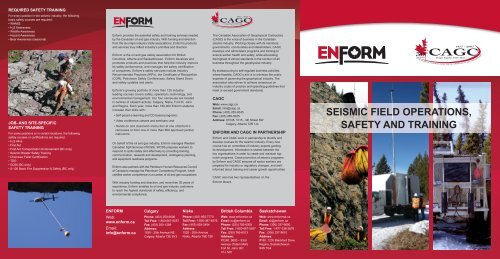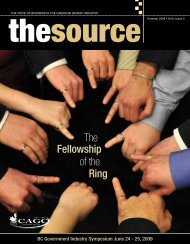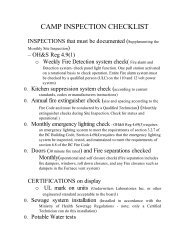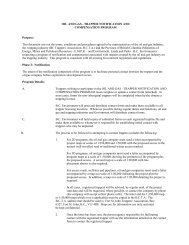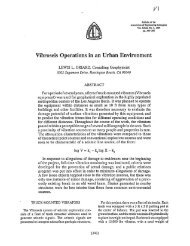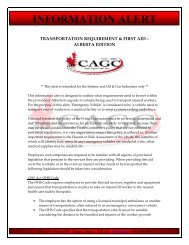seismic field operations, safety and training - Canadian Association ...
seismic field operations, safety and training - Canadian Association ...
seismic field operations, safety and training - Canadian Association ...
You also want an ePaper? Increase the reach of your titles
YUMPU automatically turns print PDFs into web optimized ePapers that Google loves.
REQUIRED SAFETY TRAININGFor every position in the <strong>seismic</strong> industry, the followingbasic <strong>safety</strong> courses are required:• WHMIS• H 2S Awareness• Wildlife Awareness• Hazard Awareness• Bear Awareness (seasonal)JOB- AND SITE-SPECIFICSAFETY TRAININGFor some positions or in certain locations, the following<strong>safety</strong> courses or certifi cations are required:• H 2S Alive• First Aid• First Aid Transportation Endorsement (BC only)• Seismic Blaster Safety Training• Chainsaw Faller Certifi cation• TDG• GODI (BC only)• S-100 Basic Fire Suppression & Safety (BC only)Enform provides the essential <strong>safety</strong> <strong>and</strong> <strong>training</strong> services neededby the <strong>Canadian</strong> oil <strong>and</strong> gas industry. With funding <strong>and</strong> directionfrom the six major industry trade associations, Enform’s products<strong>and</strong> services truly refl ect industry’s priorities <strong>and</strong> direction.Enform is the oil <strong>and</strong> gas <strong>safety</strong> association for BritishColumbia, Alberta <strong>and</strong> Saskatchewan. Enform develops <strong>and</strong>promotes products <strong>and</strong> practices that help the industry improveits <strong>safety</strong> performance, <strong>and</strong> manages the <strong>safety</strong> certifi cationof companies. Enform’s <strong>safety</strong> services include IndustryRecommended Practices (IRPs), the Certifi cate of Recognition(COR), Petroleum Safety Conferences, Safety St<strong>and</strong> Down,<strong>and</strong> <strong>safety</strong> updates <strong>and</strong> alerts.Enform’s growing portfolio of more than 120 industryleadingcourses covers <strong>safety</strong>, <strong>operations</strong>, technology, <strong>and</strong>environmental management. Our four campuses are locatedin centres of oilpatch activity: Calgary, Nisku, Fort St. John<strong>and</strong> Regina. Each year, more than 180,000 Enform studentsincrease their skills with:• Self-paced e-learning <strong>and</strong> CD-based programs;• Video conference classes <strong>and</strong> seminars; <strong>and</strong>• H<strong>and</strong>s-on <strong>and</strong> classroom instruction at one of Enform’scampuses or from one of more than 600 approved partnerinstructors.On behalf of the oil <strong>and</strong> gas industry, Enform manages Western<strong>Canadian</strong> Spill Services (WCSS). WCSS prepares workers torespond to spills safely <strong>and</strong> effectively by providing <strong>training</strong>,communication, research <strong>and</strong> development, contingency planning,<strong>and</strong> equipment readiness programs.Enform also partners with the Petroleum Human Resources Councilof Canada to manage the Petroleum Competency Program, whichcertifies worker competence in a number of oil <strong>and</strong> gas occupations.With industry funding <strong>and</strong> direction, <strong>and</strong> more than 50 years ofexperience, Enform enables its oil <strong>and</strong> gas industry customersto reach the highest st<strong>and</strong>ards of <strong>safety</strong>, effi ciency, <strong>and</strong>environmental compliance.The <strong>Canadian</strong> <strong>Association</strong> of Geophysical Contractors(CAGC) is the voice of business in the <strong>Canadian</strong><strong>seismic</strong> industry. Working closely with its members,governments, communities <strong>and</strong> stakeholders, CAGCdevelops <strong>and</strong> administers programs <strong>and</strong> <strong>training</strong> toensure worker health <strong>and</strong> <strong>safety</strong>, while advocatingthe highest of ethical st<strong>and</strong>ards in the conduct of allbusiness throughout the geophysical industry.By endeavouring to self-regulate business activitieswhere feasible, CAGC’s aim is to minimize the publicexpense of governing the geophysical industry. Theassociation also strives to achieve consensus onindustry codes of practice <strong>and</strong> operating guidelines thatmeet or exceed government st<strong>and</strong>ards.CAGCWeb: www.cagc.caEmail: info@cagc.caPhone: (403) 265-0045Fax: (403) 265-0025Address: #1045, 1015 - 4th Street SWCalgary, Alberta T2R 1J4ENFORM AND CAGC IN PARTNERSHIPEnform <strong>and</strong> CAGC work in partnership to identify <strong>and</strong>develop courses for the <strong>seismic</strong> industry. Every newcourse has an committee of industry experts guidingits development. Information is shared between thetwo organizations in order to create <strong>and</strong> maintain topnotchprograms. Cross-promotion of <strong>seismic</strong> programsby Enform <strong>and</strong> CAGC ensures all sector workers areprepared for industry or regulatory changes, <strong>and</strong> wellinformedabout <strong>training</strong> <strong>and</strong> career growth opportunities.CAGC also has two representatives on theEnform Board.SEISMIC FIELD OPERATIONS,SAFETY AND TRAININGENFORMWeb:www.enform.caEmail:info@enform.caCalgaryNiskuBritish ColumbiaSaskatchewanPhone: (403) 250-9606Toll Free: 1-800-667-5557Fax: (403) 250-1289Address:1538 - 25th Avenue NECalgary, Alberta T2E 8Y3Phone: (403) 955-7770Toll Free: 1-800-387-4976Fax: (403) 955-2454Address:1020 - 20th AvenueNisku, Alberta T9E 7Z6Web: www.enformbc.caEmail: bc@enform.caPhone: (250) 785-6009Toll Free: 1-800-667-5557Fax: (250) 785-6013Address:#1240, 9600 – 93rdAvenue (Totem Mall)Fort St. John, BCV1J 5Z2Web: www.enformsk.caEmail: sk@enform.caPhone: (306) 337-9600Toll Free: 1-877-336-3676Fax: (306) 337-9610Address:#180, 1230 Blackfoot DriveRegina, SaskatchewanS4S 7G4
SIX PHASES OF SEISMIC OPERATIONSAll <strong>seismic</strong> <strong>operations</strong> involve six important phases. Each phase needs workers in different roles, with a variety of skills <strong>and</strong> <strong>training</strong>. This griddescribes each phase of <strong>seismic</strong> <strong>operations</strong>, explains what jobs fi t into each phase <strong>and</strong> lists the <strong>training</strong> required <strong>and</strong> available for each position.The <strong>seismic</strong> sector offers lots of opportunity for workers to move around – <strong>and</strong> up – with some industry <strong>training</strong> <strong>and</strong> experience.Phase 1: L<strong>and</strong>Permitting / ScoutingPermits must be in place withall stakeholders prior to the startof any <strong>seismic</strong> program.Phase 2:Line SurveyingLine surveying is conductedin two stages. The fi rst stageincludes scouting <strong>and</strong> mappingactivities. The second stageincludes the marking of all shotholes on source lines.Phase 3:Line ConstructionLine construction of source<strong>and</strong> receiver lines is typicallycompleted by MulcherOperators <strong>and</strong>/or Fallers.Seismic lines are constructedto allow access for <strong>seismic</strong>equipment <strong>and</strong> crews.Phase 4: Shot HoleDrilling <strong>and</strong> LoadingSeismic drills travel downconstructed lines <strong>and</strong> drill shotholes in locations that havebeen pre-determined by thesurvey crews. Shot holes arethen loaded with an explosivecharge <strong>and</strong> plugged accordingto provincial regulation.Phase 5:Data Acquisition(Recording)The data acquisition(or recording) companylays out geophones. Afterdetonation from explosivesor vibroseis, data is collectedfor analysis.Phase 6: Clean-up &ReclamationUpon program completion, allwork sites must be cleanedup <strong>and</strong> reclaimed according togovernment regulations <strong>and</strong>stakeholder agreements.SFOS FOR ALL PHASESThe Seismic Field Operations Supervisor (SFOS) course(currently under re-development) will, in the fi rst quarter of 2010,become a multi-level <strong>training</strong> course with the requirement thatc<strong>and</strong>idates gain work experience between levels:• SFOS Level I – Supervisor Accountability (three-day course)• SFOS Level II – Program Management (fi ve days of <strong>training</strong>)The SFOS courses cover the supervisor’s responsibilities for allphases of a geophysical exploration project.Phase 1: L<strong>and</strong> Permitting / Scouting• Scouting• Underst<strong>and</strong>ing permits• Stakeholder communicationPhase 2: Line Surveying• Types of surveying equipment• Buried facilities locatingSeismic Permit AgentSurvey HelperGPS SurveyorBuried Facilities LocatorChainsaw BuckerMulcher OperatorFallerFaller TutorDriller’s HelperDrillerDrill PushLine Crew HelperShooter / BlasterObserverCompleted by the DataAcquisition workforceCareers /PositionsPhase 3: Line Construction• Line construction• Falling requirements• Mulcher <strong>operations</strong>• Environmental areasPhase 4: Shot Hole Drilling <strong>and</strong> Loading• Seismic drilling equipment• Seismic blaster requirement• Safe work procedures• See Permit, Plat <strong>and</strong>Release forms on the CAGCwebsite under Publications• Seismic Flagging Poster• Terrain OperationAssessment Guidelines• Geophysical MulchingOperations• Dangerous Tree Control -IRP 11• Terrain OperationAssessment Guidelines• Heli-assist / Heli-portableOperations• Seismic Activity Near NEB RegulatedPipelines• Recommended Product Testing <strong>and</strong>Specifi cations for Electric SeismicDetonators for Use in Seismic Operations• Safe Operating Procedures for SeismicDrilling <strong>and</strong> Blasting• Ground Disturbance in the Vicinity ofBuried Facilities - IRP 17• Heli-assist / Heli-portable Operations• iButton Use for Security Surveillance onExplosive Magazines• Dust Suppression on Seismic Drilling Rigs• Alberta First Aid Requirements• Alberta First Aid Requirements• Misfi red Charges / Misfi redCharges Checklist• OSCAR Program - First Aidin Heli-assist / Heli-portableOperations• Heli-assist / Heli-portableOperations• Seismic Inspection Checklists• Terrain OperationAssessment Guidelines• Seismic Crew EmploymentSt<strong>and</strong>ardsTraining Requirements &Best PracticesPhase 5: Data Acquisition (Recording)• Recording equipment• Recording parameters• Methods of data acquisitionPhase 6: Clean up <strong>and</strong> Reclamation• Regulations• ResponsibilitiesThe courses also cover topics that apply to all levels ofemployees <strong>and</strong> phases of operation, including:• OHS Regulations <strong>and</strong> Responsibilities• Hazard Assessment/Management• Incident Investigation• Journey Management• Fitness for Work• Seismic Permit Agent• Seismic Permit Agent Refresher• Buried Facilities Locator – Basic• Buried Facilities Locator – SeismicNote: Most <strong>training</strong> is subject to required, job- <strong>and</strong> site-specifi c <strong>safety</strong> <strong>training</strong>.See full Training Best Practices information at www.cagc.ca.Green = Entry level positionBlue = Intermediate Position Red = Advanced Position• Level I – Chainsaw BasicsChainsaw Faller CompetencyProgram• Level II – Faller Entry• Level III- Faller Evaluation• Level IV – Faller Tutor• Faller Challenge• Mulcher Operator• Seismic Drilling• Seismic Blaster Safety Training(with 6 months fi eld experience)• Seismic Drilling• Seismic Blaster Safety Training(depending on responsibilities)• Seismic Drilling• Seismic Blaster Safety Training• Seismic Blaster Safety Trainingwww.enform.caEnform CoursesCAGC has applied for Alberta provincial governmentoccupational registration for <strong>seismic</strong> <strong>field</strong> <strong>operations</strong>supervisors under the Professional <strong>and</strong> Occupational<strong>Association</strong>s Registration Act (POARA). Only supervisors whohave completed the SFOS Level II – Program Managementcourse will be eligible to apply for the POARA designation.All designated POARA SFOS’s must renew their CAGCmembership annually to retain their designation.


